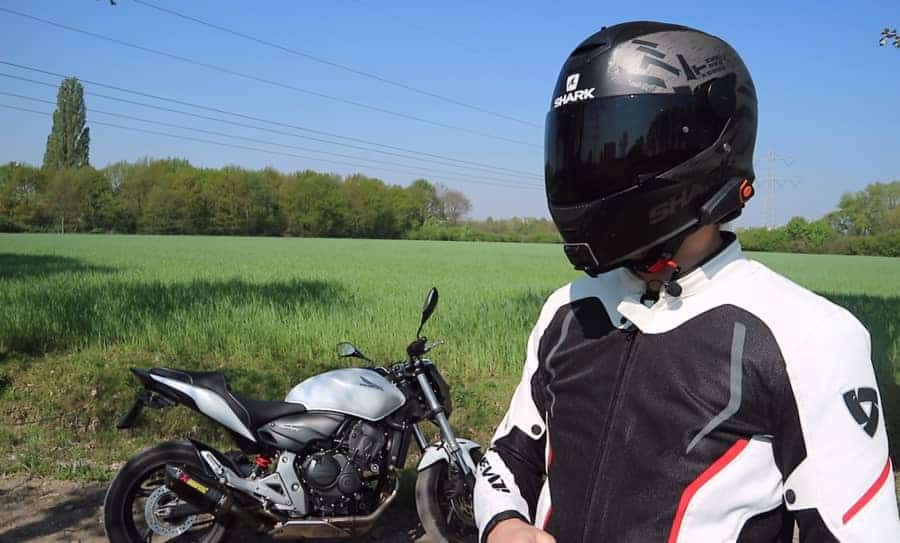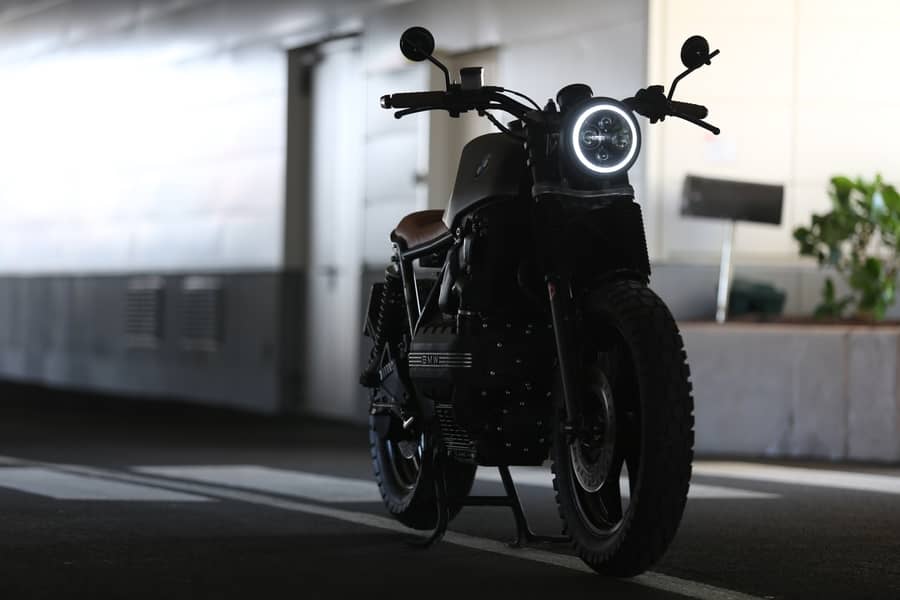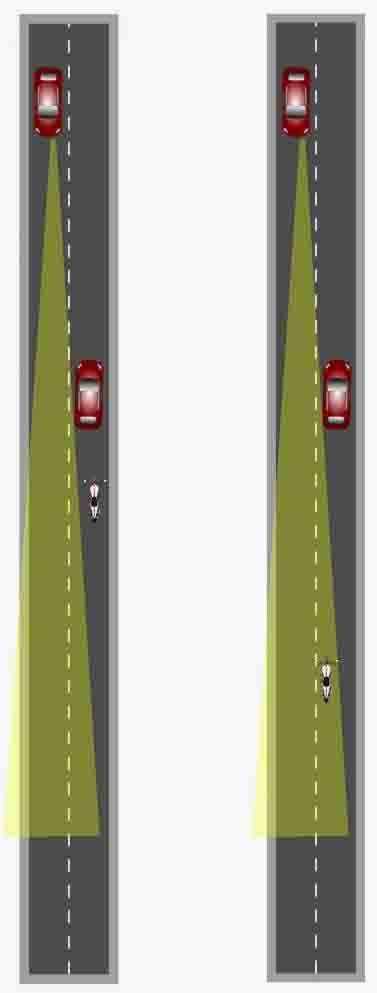By many people, riding a motorcycle is considered dangerous. And to be fair, the injuries caused by an accident are relatively higher for motorcyclists than for other vehicles like cars.
But that doesn’t stop us motorcycle riders from enjoying the freedom our motorcycles give us.
I like to enjoy this freedom and I’ll keep riding my motorcycle, even when I know it’s more dangerous than driving a car. We should, however, try to minimize the risks of an accident.
That’s why I came up with 9 safety tips for motorcyclists, to keep you safe as much as possible.
1. Protect your eyes
Protecting your eyes should be one of your main priorities. It’s not just your eye that is hurting when anything gets in it, it also endangers the rest of your body. You’ll need your eyes to see where you are going and to keep upright. Temporarily going blind can cause a crash with serious injuries as a result.
There are several ways to protect your eyes. First of all, you could and should wear a helmet with eye protection. Most full-face helmets have a visor which protects your eyes from wind, sand and other obstacles. All you need to do is keeping that visor down at all times!
Other helmets, like dirt bike helmets, don’t have visors. Those helmets are typically used in combination with goggles. These goggles will also protect your eyes from any hazards.
Motorcycle windscreens do not protect your eyes. Some people think a windscreen is fine, but it just keeps you out of the wind! Sand, stones, and bugs can still get into your eyes, so you should always protect them. Don’t want to use a visor or goggles? Combine your motorcycle windscreen with a pair of (sun)glasses. Just make sure these glasses are strong enough to protect you from stones. They shouldn’t scatter in your face, cause more harm than doing anything good to you.

2. Wear protective motorcycle gear
This one sounds pretty obvious, but there are still loads of people out there than don’t wear the right protective clothing.
Make sure to at least wear a helmet, gloves, strong boots above the ankles, protective pants and a protective jacket.
Have you ever fallen whiles running as a kid? Remember that road rash on your knee and the wound it would give? That’s just with a speed of 3 miles an hour. On your motorcycle, you could be doing 20 times that speed!
The road is like a grater. It will make minced meat of your body! Please, just do me a favor and wear that protective gear! Even at low speeds, you can get serious painful injuries by going down. Just think of it… Would you run into a brick wall as fast as you can? No! And you’ll only be doing 10 miles an hour.
Some people say stuff like “It’s ok, I’ll stay within the city limits”. Meanwhile, they are doing 30 miles an hour, which is 3 times as fast as running into a brick wall!
I personally wear a pair of motorcycle jeans when I plan to stay close to my house. They have the flexibility of jeans, but at least they protect my skin from that grater called the asphalt.
3. Follow the traffic rules
Following the traffic rules doesn’t ensure that you stay safe, but it decreases the chance of accidents dramatically.
Don’t be on your phone, don’t speed, don’t run red lights and don’t undertake other vehicles. All these things take your mind off the traffic or they surprise other roadusers.
You can’t blame a car that pulls out in front of you when you are doing 60 mph in a 30 mph zone. They’ll think they have plenty of time to get into the road before you, not realizing you are speeding.
I’m not saying that I never break any traffic law, I do speed at some points. But it surely doesn’t increase my safety.
4. Ride defensively
This means you should always expect the least expected. Is the car in front of you moving over to the right? Don’t hit the gas to overtake it, but slow down for a second. See what he is doing. You’ll be surprised to see how many car drivers ‘miss’ a motorcycle and just do a U-Turn right in front of you without indicating.
It’s these kinds of situations that you have to get yourself familiar with. Expecting the unexpected can keep you from potential life-threatening situations.
Personally, I ride my bike as if I am invisible. Because I am, to some idiotic road users that don’t watch out. I try to get eye contact to confirm if I’ve been seen before I make my move.

5. Be seen by other road users

This next tip has a close connection with the previous one. You should try whatever you can to be noticed and seen by other road users.
First of all, you should always ride with your lights on. Most motorcycles cannot be driven with the lights off, but the older models still have the capability of doing this. Make sure yours is always on. You might also want to consider adding extra auxiliary lighting to your motorcycle to be seen.
Your position on the road is also crucial. Riding 5 feet right or left of the middle of the lane can be the difference between being seen or not. The image on the right side shows how important it is to keep your distance and ride on the side of the road that you’ll be seen.
My last tip for being seen is the use of reflective tape. It’s a great product to make yourself more visible during the night.
I actually wrote a complete article about being more visible in traffic, you can find it by clicking this link.
6. Keep and improve your riding skills
Passing the driving exam and earning your motorcycle driving license doesn’t mean you are a good motorcyclist. In fact, it only starts when you get your license. You’ll have to gain more experience and keep up with this experience.
Make sure you ride your motorcycle regularly. My dad, for example, has a motorcycle license. But he didn’t ride any motorcycle for over thirty years.
Driving your motorcycle around is a great way to gain experience. Another way to get better and more comfortable is by taking advanced driving courses. You’ll learn everything about cornering techniques, braking and dodging around obstacles. These courses aren’t very cheap, but they are great fun and they could potentially save your life.
7. Stay sober when you are riding
You should obviously not be drinking when driving. This counts for every type of vehicle, but especially for a motorcycle. It’s a vehicle of balance, and your balance is affected when you drink alcohol or do any type of drugs.
Besides drinking, you should also make sure you rest well. I’ve experienced first hand what fatigue does to your driving, and it isn’t any good. In fact, some say that fatigue is even more dangerous than drinking and driving.
Also make sure to stay hydrated, especially during the hot summer days. You can ride for hours and enjoy the wind on your face, but don’t forget to stop regularly to drink some water. Getting dehydrated gives you a headache, and it will be too late by the time you head tells you to drink.
8. Inspect your motorcycle before you leave
One of the important things to do before you go out for a ride is the inspection of your motorcycle. I have to admit that I’m bad at doing this.
There are some key factors you should check before you take your buddy out for the road.
- Tires: Check if your tires are still under good pressure. You don’t have to measure it every day, but at least check if your tires are not flat. Also, make sure they are in good condition. Things you want to look for are nails, cracks or defects in your tires.
- Check the ground: Always check the area under your motorcycle when you move it from the parking area. Check if you see any oil or gas on the ground. If so, check your motorcycle for leaks.
- Lights: Always check your lights, especially when you go out in the dark. A car has at least two taillights, a motorcycle only has one! A defect taillight can be a huge safety risk, so you want to avoid that at all times. Also, check your indicator, you are checking the lights already anyways.
- Fluid levels: Last but not least, check your fluid levels. Check your oil, coolant fluid, and braking fluid. You might need to fill or replace the oil once every while, but the coolant or breaking fluid shouldn’t go empty. This probably means there is a leak at some point and you shouldn’t ride your motorcycle until it is fixed.
- Horn: I personally don’t do it, but it’s best to check if your horn is working before you leave.
- Breaks: Just test your brakes. Rather find out they are not working whiles going 10 miles an hour in your own road, than going 60 miles an hour on a highway.
9. Wear proper motorcycle earplugs
This one is not known to everybody. Wearing the right earplugs really improves your safety. They filter out wind noise and make it easier to hear stuff like sirenes and horns.
Just make sure you are wearing the right type of motorcycle earplug. A normal foam earplug will just block ANY sound, which decreases your safety level! I wrote more about this in my article over earplugs on a motorcycle.
